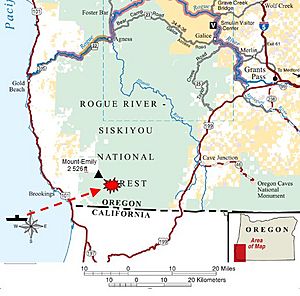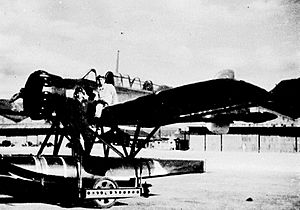Lookout Air Raids facts for kids
Quick facts for kids Lookout Air Raids |
|||||||
|---|---|---|---|---|---|---|---|
| Part of the American theater and Pacific theater of World War II | |||||||
 Lookout air raid schema |
|||||||
|
|||||||
| Belligerents | |||||||
| Commanders and leaders | |||||||
| Keith V. Johnson | Tagami Akiji Nobuo Fujita |
||||||
| Strength | |||||||
| 1 patrol of fire lookouts | Sea: 1 submarine Air: 1 aircraft |
||||||

The Lookout Air Raids were small but important air attacks by Japan during World War II. They happened in the mountains of Oregon, near a town called Brookings.
On September 9, 1942, a Japanese Yokosuka E14Y Glen floatplane took off from a Japanese submarine. It dropped two special bombs designed to start forest fires. However, thanks to brave fire lookouts and wet weather, the fires did not spread much. This attack was the first time an enemy aircraft bombed the main part of the United States. It was also the second time the continental U.S. was attacked by enemy aircraft during World War II. The first attack happened three months earlier at Dutch Harbor in Alaska.
What Happened During the Lookout Air Raids?
On the morning of Wednesday, September 9, 1942, the Japanese submarine I-25 came to the surface. It was west of Cape Blanco in Oregon. The submarine launched a "Glen" Yokosuka E14Y floatplane. This plane was flown by Nobuo Fujita and Okuda Shoji. They carried two special bombs, each weighing about 76 kilograms (168 pounds). These bombs were meant to start fires.
Howard "Razz" Gardner was a fire lookout on Mount Emily in the Siskiyou National Forest. He saw the "Glen" plane flying in the sky. Even though Razz did not see the bombs drop, he saw smoke. He quickly reported the fire to his office. He was told to hike to the fire and try to put it out. Another fire lookout, Keith V. Johnson, also went to help.
Fujita dropped two bombs. One landed on Wheeler Ridge on Mount Emily in Oregon. This was about 16 kilometers (10 miles) east of Brookings. The location of the second bomb is still unknown. The bomb on Wheeler Ridge started a small fire.
Razz and Keith quickly reached the fire. They worked through the night to keep the flames from spreading. The bombs did not start big fires because they were not dropped from the correct height. Also, recent rain had made the area wet. This helped the fire lookouts control the blaze. The next morning, a fire crew arrived to help them.
After the Attacks
An investigation was started to find out more about the attack. They found pieces of the bombs. News about the attack was shared in newspapers on September 10, 1942. A military commander, Lieut. Gen. John L. DeWitt, announced that the bomb pieces were Japanese.
The floatplane carried two bombs, and both were dropped. However, only one bomb site was found. The bomb that was found left a hole about a foot deep in the ground. Fujita and his observer made a second attack on September 29. Again, they caused very little damage.
A Story of Peace and Friendship
Twenty years after the air raids, the pilot, Nobuo Fujita, was invited back to Brookings. Before he came, the Japanese government was told he would not be punished for his actions during the war. In Brookings, Fujita was a special guest at the local Azalea Festival.
At the festival, Fujita gave the city his family's 400-year-old samurai sword. This was a symbol of his regret for the attacks. Fujita visited Brookings many more times. He became an "informal ambassador of peace and friendship." He was very touched by how he was welcomed in the United States.
In 1985, Fujita invited three students from Brookings-Harbor High School to visit Japan. During their visit, Fujita received a special letter from an aide to President Ronald Reagan. The letter praised Fujita for his kindness. Fujita returned to Brookings in 1990, 1992, and 1995. In 1992, he planted a tree at the bomb site as a sign of peace. In 1995, he moved the samurai sword to the new library in Brookings.
Fujita was made an honorary citizen of Brookings just a few days before he passed away on September 30, 1997, at 85 years old. In October 1998, his daughter, Yoriko Asakura, buried some of Fujita's ashes at the bomb site.


